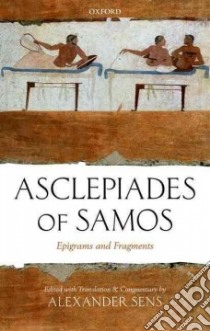Asclepiades of Samos - 9780199253197
Un libro in lingua di Alexander Sens edito da Oxford University Press, 2010
- € 191.30
- Il prezzo è variabile in funzione del cambio della valuta d’origine
Saffron-Robed Monks and Long-Haired Gurus have become familiar characters on the American popular culture scene. Jane Iwamura examines the contemporary fasination with Eastern spirituality and provides a cultural history of the representation of Asian religions in American mass media. Encounters with monks, gurus, bhikkhus, sages, sifus, healers, and masters from a wide variety of ethnic backgrounds and religious traditions provided initial engagements with Asian spiritual traditions. Virtual Orientalism shows the evolution of these interactions, from direct engagements with specific individuals to mediated relations with a conventionalizedicon: the Oriental Monk. Visually and psychically compelling, the Oriental Monk becomes for Americans a "figure of translation"---a convenient symbol for alternative spiritualities and modes of being. Through the figure of the solitary Monk, who generously and purposefully shares his wisdom with the West, Asian religiosity is made manageable---psychologically, socially, and politically---for popular culture consumption. Iwamura's insightful study shows that though popular engagement with Asian religions in the United States has increased, the fact that much of this has taken virtual form makes stereotypical constructions of "the spiritual East" obdurate and especially difficult to challenge.
"Jane Iwamura has an uncanny and impressive way of combining popular culture, hermeneutics, studies in digitalization, categories of ethnic and racial formation, and US religious studies. This book provides an important introduction to a set of major Orientalist figures in popular genres that has not yet been given adequate scholarly attention. Iwamura's approach to popular culture is very deft: she not only pays close attention to the images at hand, but exposes what she takes to be the national and racial anxieties at play there through a close reading of the images' dissonant interpretations."---Judith Butler, Maxine Elliot Professor of Rhetoric and Comparative Literature at the University of California at Berkeley
Informazioni bibliografiche
- Titolo del Libro in lingua: Asclepiades of Samos
- Sottotitolo: Epigrams & Fragments
- Lingua: English
- Autore: Alexander Sens
- Editore: Oxford University Press
- Collana: (Hardcover)
- Data di Pubblicazione: 30 Gennaio '10
- Genere: LITERARY CRITICISM
- Argomenti : Epigrams, Greek Translations into English
- ISBN-10: 0199253196
- EAN-13: 9780199253197


